Recorded crime in Scotland: handling offensive weapons
This report presents information on handling offensive weapons recorded by the police.
2. Trends in crimes of handling weapons
Introduction
This section provides an overview of the main statistical sources on handling offensive weapons in Scotland, including changes over time. These statistics include police recorded crime, criminal proceedings, public perceptions of knife carrying, and emergency hospital admissions due to assault with a sharp object.
Police Recorded Crime
The National Statistics on Recorded Crime in Scotland [3] include information on crimes of handling offensive weapons. It should be noted that these statistics do not show the overall incidence of handling offensive weapons in Scotland, as they only include those incidents which have come to the attention of the police. Chart 1 below presents statistics for crimes of handling offensive weapons over the past 20 years, from 1997-98 to 2016-17.
Chart 1: Crimes of handling offensive weapons recorded by the Police, 1997-98 to 2016-17.
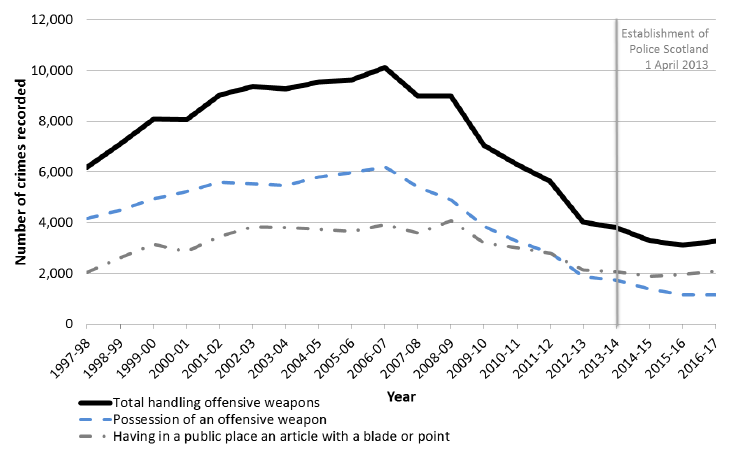
Source: National Statistics on Police Recorded Crime, Scotland
In 1997-98 there were 6,191 crimes of handling offensive weapons recorded by the police in Scotland. This figure steadily increased throughout the following decade, before it peaked at 10,110 in 2006-07. Crimes of handling offensive weapons then fell substantially over the following decade, with 3,271 recorded in 2016-17, 68% lower than the 2006-07 peak.
Crimes of handling offensive weapons can be split into possession of an offensive weapon (for example glass bottles or knuckledusters) or having in a public place an article with a blade or point. In both cases, levels generally increased up to 2006-07, before they fell markedly over the following decade (replicating the overall trend for handling offensive weapons). The post 2006-07 fall in possessing an offensive weapon was larger than the rise that preceded it. As such these crimes were 72% lower by 2016-17 than 1997-98. The post 2006-07 fall in having in a public place an article with a blade or point was very similar to the rise that preceded it, leaving levels recorded in 2016-17 (2,092 crimes) almost identical to the position in 1997-98 (2,030 crimes).
At present, the National Statistics on crimes of handling offensive weapons only relate to where the weapon was not used to commit a crime or offence against a person in a public setting (for example a robbery or a serious assault). If the weapon had been used in this way, it would have been treated as an aggravation of the crime/offence against a person, rather than been recorded separately. As such, whilst the presence of a weapon is a factor in some violent crimes, these figures do not provide information on the level of weapons-related violence committed in Scotland [4] .
Nonetheless, changes in the volume of non-sexual violent crime recorded by the police over the past 20 years have shown some similarity to the changes described above for crimes of handling offensive weapons. Chart 2 below presents statistics for the number of non-sexual violent crimes recorded by the police from 1997-98 to 2016-17.
Chart 2: Crimes of Non-sexual violence recorded by the Police, 1997-98 to 2016-17.
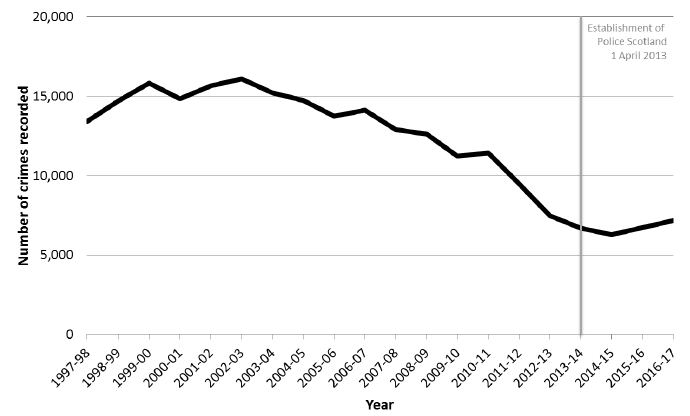
Source: National Statistics on Police Recorded Crime, Scotland
In 1997-98 there were 13,394 non-sexual crimes of violence recorded by the police in Scotland. This figure fluctuated somewhat before peaking at 16,074 in 2002-03. Non-sexual crimes of violence then generally fell over the next 10 years and beyond, with 7,164 recorded in 2016-17, 55% lower than the 2002-03 peak.
Criminal Proceedings
National Statistics are also available on people proceeded against in court for handling offensive weapons [5] . Chart 3 below presents statistics on people convicted where the main charge [6] was for handling offensive weapons over the past 20 years, from 1997-98 to 2016-17.
In 1997-98 there were 2,173 people convicted in court for handling offensive weapons. This figure then increased over the following years, in a similar manner to the number of crimes of handling offensive weapons recorded by the police, to peak at just above 3,500 during each year between 2004-05 and 2008-09 inclusive. Since 2008-09, and again reflecting the significant decrease in police recorded crime, the number of people convicted for handling offensive weapons has fallen sharply, by 59% to 1,436 in 2016-17.
Chart 3: People convicted in court for Handling Offensive Weapons, 1997-98 to 2016-17
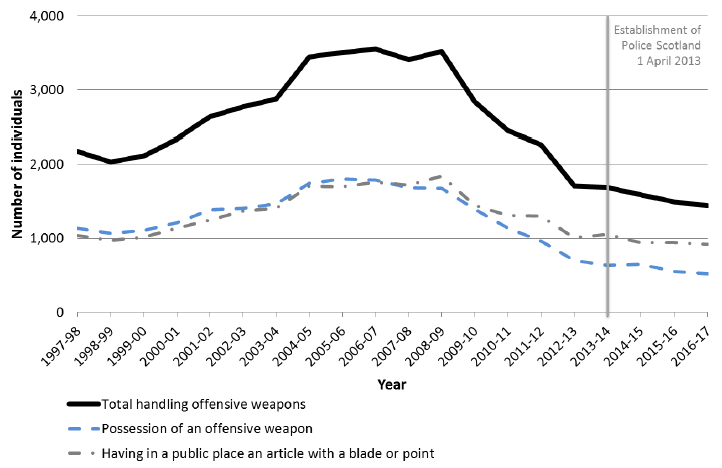
Source: National Statistics on Criminal Proceedings in Scotland
The statistics on convictions also provide further information on the characteristics of these cases. Over the past 20 years, 94% of those convicted for handling offensive weapons were male (46,900 out of 49,810 over 1997-98 to 2016-17). At the same time two trends were apparent in the median age of offenders. Over the first half of the period (from 1997-98 to 2006-07), the median age of offenders remained very stable at between 22 and 23 years old. During the second half of the period (from 2007-08), the median age increased steadily, from 24 years to 29 years (Chart 4).
Chart 4: Median age of people convicted for Handling Offensive Weapons, 1997-98 to 2016-17.
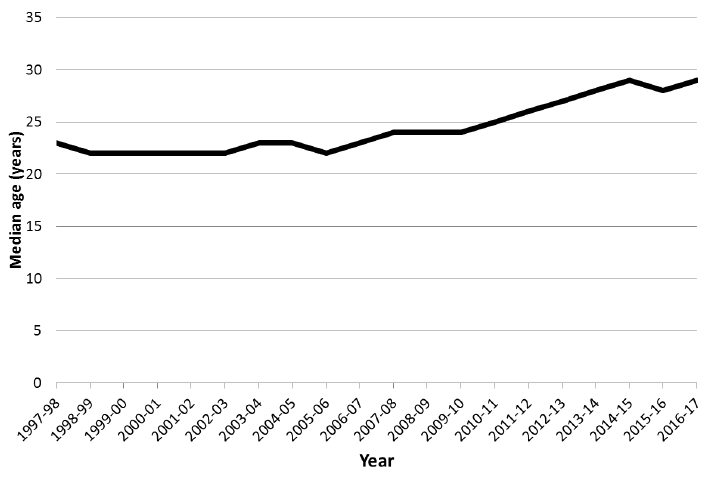
Source: National Statistics on Criminal Proceedings in Scotland
Those convicted of handling an offensive weapon in 2016-17 were most likely to receive a community sentence (43%) or some form of custodial sentence (34%). The proportion of convictions resulting in a custodial sentence has generally fluctuated between 30% and 40% each year between 2007-08 and 2016-17. During this time the average sentence length increased steadily from 218 days to 391 days.
Scottish Crime and Justice Survey
The Scottish Crime and Justice Survey ( SCJS) is a large-scale social survey which asks adults about their experiences and perceptions of crime [7] . The survey plays an important role in assessing the picture of crime in Scotland as it includes crimes that have not been reported to the police, and as such do not appear in the National Statistics on police recorded crime.
The SCJS estimates that the total number of violent crimes committed in Scotland fell by more than a quarter between 2008-09 and 2016-17, from 317,000 to 231,000. Over the same period, the proportion of adults experiencing at least one violent crime fell from 4.1% to 2.9%. It was estimated that 43% of violent crimes committed in 2016-17 were reported to the police.
The survey also found that violent crime in 2016-17 did not commonly involve the presence or use of weapons, with only 15% of incidents said to have involved perpetrators with weapons [8] .
In addition to asking adults about their experiences of crime, the SCJS includes a series of questions on whether they perceive particular issues to be very or fairly common in their area. This includes the issue of people carrying knives. Chart 5 below presents statistics on this question from 2009-10 (the first year it was asked) to 2016-17.
In 2009-10, 22% of adults in Scotland believed knife carrying was very or fairly common in their local area. This figure more than halved over the period up to 2016-17, by which point 10% of adults believed knife carrying was very or fairly common. Adults were more likely to believe knife carrying was very or fairly common in their local area if they lived in one of Scotland’s 15% most deprived areas (29% in 2016-17, compared to 6% for everywhere else). They were also more likely to believe knife carrying was common if they lived in an urban area (12% compared to 3% for rural areas).
Chart 5: Proportion of adults who believe knife carrying in their local area is very or fairly common, 2009-10 to 2016-17.
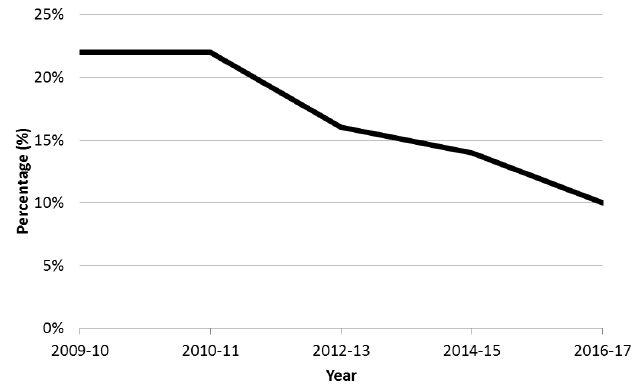
Source: Scottish Crime and Justice Survey National Statistics
Hospital Admissions
Another source of statistics relating to the handling of offensive weapons in Scotland comes from ISD Scotland’s Unintentional Injuries release. This includes emergency hospital admissions as a result of assault with a sharp object [9] .
Chart 6 below presents statistics for the number of emergency hospital admissions as a result of assault with a sharp object from 1997-98 to 2016-17. In 1997-98 there were 1,318 admissions due to assault with a sharp object. This figure increased substantially to a peak in 2002-03 (1,884) before falling back to previous levels in 2008-09. Since then, admissions due to assault with a sharp object have fallen substantially, down 64% to 517 by 2016-17.
It is not possible to make a direct comparison between police recorded crimes of having in a public place an article with a blade or point and emergency hospital admissions as a result of an assault with a sharp object - as the former only relates to cases where the bladed or pointed article hasn’t been used in a crime against a person (so by definition cannot include an assault). However, as these sources both generally relate to the presence of weapons in Scotland (one the volume of weapons possession recorded by the police and the other the volume of hospital admissions due to assault with a weapon) – it might be anticipated that both should show similar trends over time.
As noted above, there were 517 emergency hospital admissions as a result of assault with a sharp object in 2016-17. This represents a decrease of 59% over the past decade, from 1,261 in 2007-08. This comparison confirms that the significant reduction in police recorded crimes of handling offensive weapons over the past decade has also been broadly reflected in statistics for emergency hospital admissions due to assault with a sharp object.
Chart 6: Emergency admissions to hospital as a result of assault with a sharp instrument, 1997-98 to 2016-17.
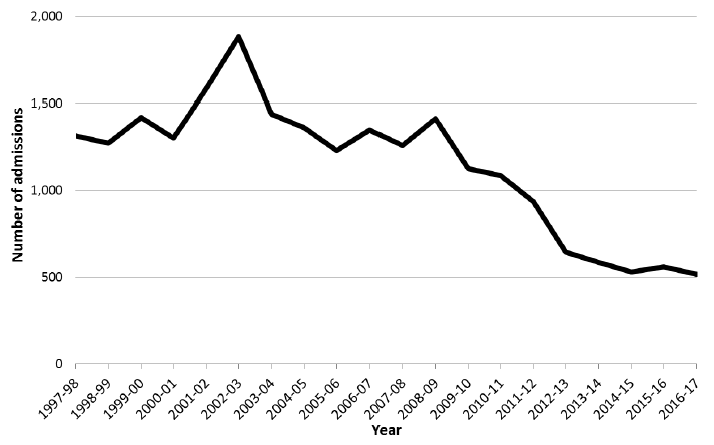
Source: National Statistics on Unintentional Injuries in Scotland ( ISD Scotland).
Summary of Trends in Handling Weapons
This section presents the main statistics that relate to handling offensive weapons in Scotland.
Whilst each of these sources measures a different aspect of weapon-related offending (including both Justice and Health-based measures, and administrative/survey-based data), they all point to a substantial and long term reduction in this activity over the past decade (Chart 7). As fewer cases of handling offensive weapons were being recorded by the police, resulting in fewer people being convicted – both the number of adults who believed knife carrying was common in their local area and the number of emergency hospital admissions due to assault with a sharp object also fell. There was a similar reduction over the past decade in the number of non-sexual violent crimes both experienced by the population and recorded by the police.
Those that were convicted of handling an offensive weapon remain overwhelmingly male and were older by 2016-17 than their counterparts 10 years earlier (with the median age of those convicted increasing from 24 to 29 years old).
Chart 7: Indices in selected measures, Scotland, 1997-98 to 2016-17 (Index 1997-98 = 100).
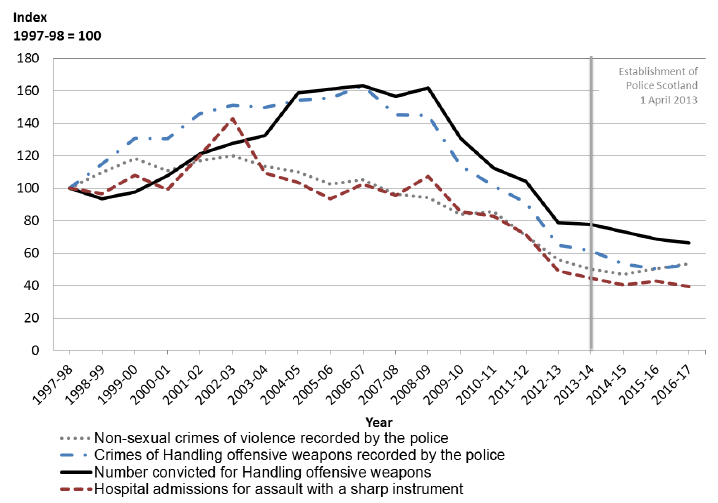
Contact
There is a problem
Thanks for your feedback